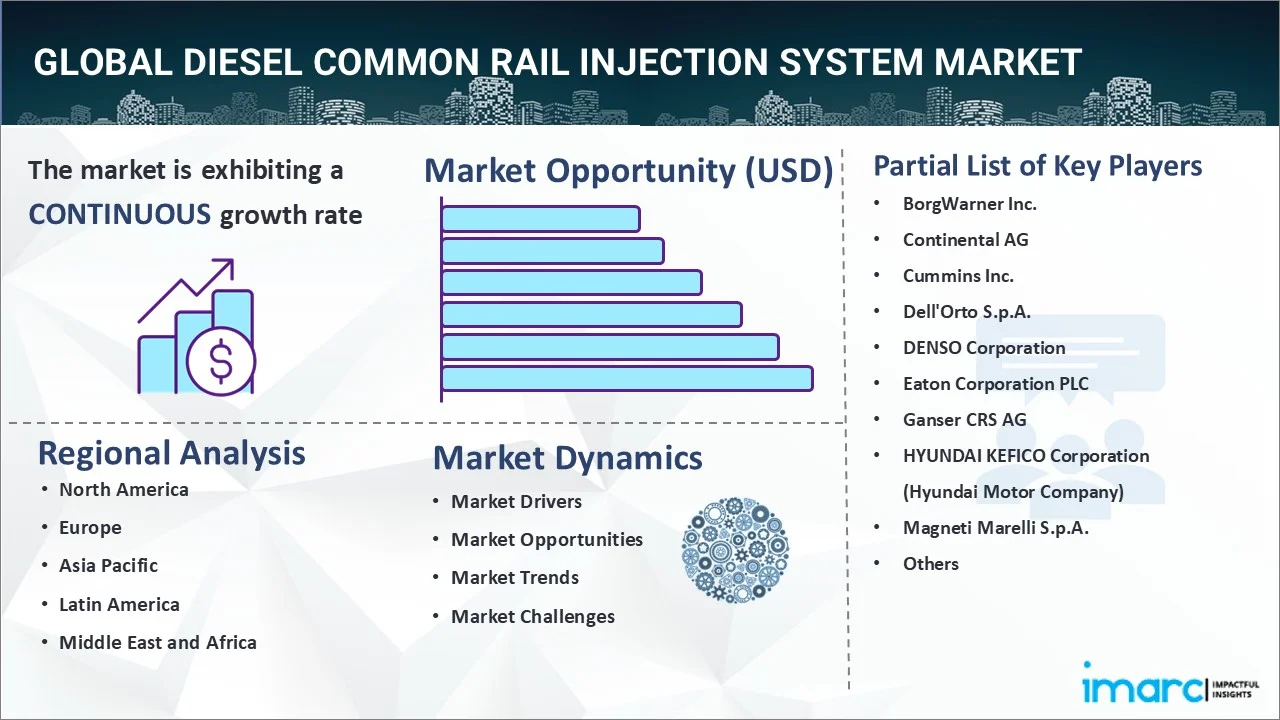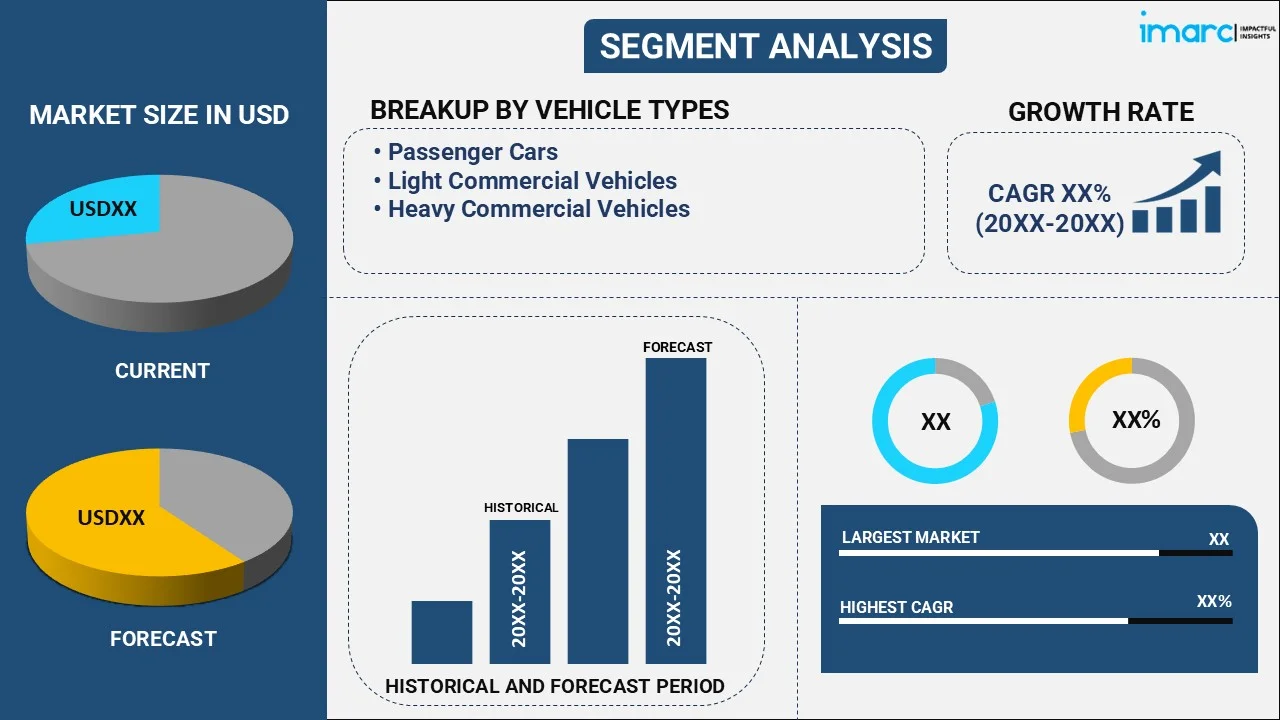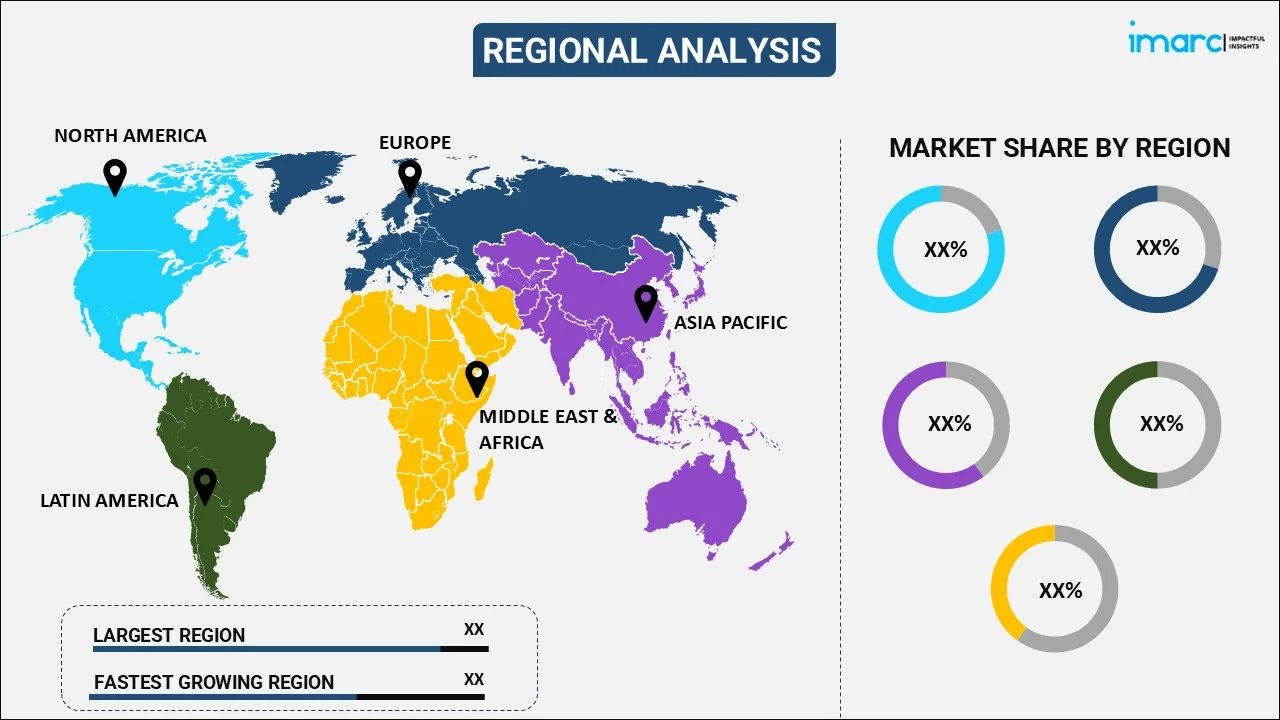
Diesel Common Rail Injection System Market Report by Vehicle Type (Passenger Cars, Light Commercial Vehicles, Heavy Commercial Vehicles), Fuel Injector Type (Solenoid Injector, Piezoelectric Injector), Engine (Old Diesel Engine, CRDI Engine), Sales Channel (OEMs, Aftermarket), and Region 2025-2033
Global Diesel Common Rail Injection System Market:
The global diesel common rail injection system market size reached USD 3.7 Billion in 2024. Looking forward, IMARC Group expects the market to reach USD 4.9 Billion by 2033, exhibiting a growth rate (CAGR) of 3.02% during 2025-2033. The increasing demand for fuel efficiency, stricter emission standards and regulations, ongoing technological advancements in diesel engines, and growing commercial vehicle production are primarily driving the market's growth.
|
Report Attribute
|
Key Statistics
|
|---|---|
|
Base Year
|
2024
|
|
Forecast Years
|
2025-2033
|
|
Historical Years
|
2019-2024
|
|
Market Size in 2024
|
USD 3.7 Billion |
|
Market Forecast in 2033
|
USD 4.9 Billion |
| Market Growth Rate 2025-2033 | 3.02% |
Diesel Common Rail Injection System Market Analysis:
- Major Market Drivers: There is currently a rise in the demand for diesel engines across the globe due to their better fuel economy and longer shelf life. This, along with the growing utilization of commercial vehicles to transport goods and passengers for increasing profit of an individual or business, represents one of the key factors driving the diesel common rail injection system market growth.
- Key Market Trends: Key market players are extensively investing in research and development (R&D) activities to introduce enhanced injection technologies. This, coupled with the rising demand for diesel vehicles compared to petrol vehicles due to the lower prices of diesel, is propelling the diesel common rail injection system market size. Apart from this, the growing applications of diesel engines in heavy construction equipment to achieve a higher torque even at lower speeds and greater revolutions per minute (RPM) is projected to catalyze the employment of diesel common rail injection systems in the construction industry.
- Competitive Landscape: Some of the prominent diesel common rail injection system market companies BorgWarner Inc., Continental AG, Cummins Inc., Dell'Orto S.p.A., DENSO Corporation, Eaton Corporation PLC, Ganser CRS AG, HYUNDAI KEFICO Corporation (Hyundai Motor Company), Magneti Marelli S.p.A., and Robert Bosch GmbH, among many others.
- Geographical Trends: According to the diesel common rail injection system market dynamics, Asia-Pacific currently dominates the global market. The Asia-Pacific region is one of the largest hubs for automotive production, with countries like China, Japan, South Korea, and India being major producers of vehicles. The demand for fuel-efficient diesel engines, particularly in commercial vehicles such as trucks, buses, and heavy-duty transport vehicles, is driving the adoption of common rail injection systems.
- Challenges and Opportunities: The increasing inclination towards electric vehicles and stringent emission regulations are hampering the market's growth. However, advancements in diesel engine technology, such as higher injection pressures, improved electronic control units (ECUs), and better fuel atomization, are creating opportunities to develop more efficient and environmentally friendly diesel common rail systems. These technologies help in meeting stringent emissions norms while maintaining diesel’s high torque and fuel efficiency.

Diesel Common Rail Injection System Market Trends:
Expanding Commercial Vehicles Industry
The growing commercial vehicles industry is driving the market's growth. For instance, according to IMARC, the global commercial vehicles market size reached US$ 803.6 Billion in 2023. Looking forward, IMARC Group expects the market to reach US$ 1,114.2 Billion by 2032, exhibiting a growth rate (CAGR) of 3.6% during 2024-2032. Diesel engines equipped with common rail injection systems are widely used in these vehicles including heavy-duty trucks, buses, agricultural machinery, and construction equipment due to their power, efficiency, and durability. These factors are expected to propel the diesel common rail injection system market share in the coming years.
Government Regulations
Governments across the world, particularly in Europe, Asia-Pacific, and North America, are enforcing stricter emission standards. These regulations target reductions in nitrogen oxides (NOx) and particulate matter emissions. For instance, in December 2023, Colorado took action to fulfill the NOx reduction target for 2025. The Colorado Air Quality Control Commission accomplished this by enacting laws that limit emissions from stationary engines. Also, in March 2024, the CDPHE Air Pollution Control Division established the NOx Reduction Steering Committee and began planning to meet the 2030 reduction objective. These NOx reduction targets compel manufacturers to adopt common rail injection systems that reduce harmful emissions. These factors further positively influence the diesel common rail injection system market share.
Technological Advancements
Technological innovations in diesel engines, such as low injection pressures, precise fuel delivery, and improved electronic control units (ECUs), have enhanced the efficiency and performance of diesel engines. For instance, in September 2024, PHINIA Inc., a premium fuel systems, electrical systems, and aftermarket solutions company, introduced the first electronically controlled, low-pressure common rail injection system for tiny diesel engines used in off-highway applications with Kohler Engines. These advancements are making diesel common rail systems more attractive, helping to meet emissions regulations while maintaining engine performance, thereby boosting the diesel common rail injection system market growth.
Global Diesel Common Rail Injection System Industry Segmentation:
IMARC Group provides an analysis of the key trends in each sub-segment of the global diesel common rail injection system market report, along with forecasts at the global, regional, and country levels from 2025-2033. Our report has categorized the market based on vehicle type, fuel injector type, engine, and sales channel.
Breakup by Vehicle Type:

- Passenger Cars
- Light Commercial Vehicles
- Heavy Commercial Vehicles
Passenger cars exhibit a clear dominance in the market
The report has provided a detailed breakup and analysis of the diesel common rail injection system market based on the vehicle type. This includes passenger cars, light commercial vehicles, and heavy commercial vehicles. According to the report, passenger cars exhibit a clear dominance in the market.
According to the diesel common rail injection system market outlook, diesel engines with common rail injection systems are more fuel-efficient than traditional injection systems. This is particularly advantageous for passenger cars, as consumers and manufacturers strive to meet fuel economy standards and reduce operational costs. Moreover, diesel engines offer higher torque at lower RPMs compared to gasoline engines, which provides better acceleration and pulling power. This makes them especially appealing for larger passenger vehicles such as SUVs and crossovers.
Breakup by Fuel Injector Type:
- Solenoid Injector
- Piezoelectric Injector
The report has provided a detailed breakup and analysis of the diesel common rail injection system market based on the fuel injector type. This includes solenoid injector, and piezoelectric injector.
According to the diesel common rail injection system market overview, solenoid injectors are widely used in internal combustion engines due to their durability, cost-effectiveness, and reliability. These injectors use an electromagnetic solenoid to control the fuel injection process. These injectors are generally more cost-effective, making them a popular choice for mass-market vehicles and applications where cost sensitivity is a concern. Moreover, piezoelectric injectors use piezoelectric crystals to control fuel injection with greater precision than solenoid injectors. They are commonly used in high-performance, fuel-efficient, and low-emission diesel and gasoline engines. As automakers push for more fuel-efficient vehicles to meet consumer demand and regulatory requirements, piezoelectric injectors are increasingly adopted in premium passenger vehicles and luxury cars, where efficiency and performance are paramount.
Breakup by Engine:
- Old Diesel Engine
- CRDI Engine
The report has provided a detailed breakup and analysis of the diesel common rail injection system market based on the engine. This includes old diesel engine, and CRDI engine.
Old diesel engines refer to traditional diesel engines that predate modern technologies like common rail direct injection. These engines often use mechanical fuel injection systems, are less efficient in terms of fuel consumption and emissions, but have been valued for their simplicity, durability, and cost-effectiveness. Moreover, these are typically less expensive to manufacture and maintain compared to modern engines with advanced electronic control systems. Their mechanical simplicity makes them easier to repair, especially in markets where access to advanced diagnostic tools or parts for newer technologies may be limited. Moreover, CRDI engines represent the modern evolution of diesel engine technology, using common rail direct injection to improve fuel efficiency, reduce emissions, and enhance engine performance. These engines are widely used in modern vehicles and machinery. CRDI engines provide significantly better fuel efficiency and lower emissions compared to old diesel engines. The common rail system allows for precise control over fuel injection timing and quantity, optimizing combustion and reducing waste. This leads to better mileage and reduced environmental impact.
Breakup by Sales Channel:
- OEMs
- Aftermarket
The report has provided a detailed breakup and analysis of the diesel common rail injection system market based on the sales channel. This includes OEMs and aftermarket.
OEMs provide diesel common rail injection systems for new vehicles directly from manufacturers. The growth in production of diesel-powered vehicles, particularly in commercial vehicles, SUVs, and heavy-duty trucks, fuels demand for OEM diesel common rail injection systems. Moreover, the aftermarket involves the sale of replacement parts, upgrades, and retrofitting for vehicles already in use. As vehicles age, the maintenance and replacement of diesel common rail injection systems become necessary to ensure optimal engine performance and efficiency. Over time, components like injectors, fuel pumps, and sensors wear out and need to be replaced.
Breakup by Region:

- North America
- United States
- Canada
- Asia-Pacific
- China
- Japan
- India
- South Korea
- Australia
- Indonesia
- Others
- Europe
- Germany
- France
- United Kingdom
- Italy
- Spain
- Russia
- Others
- Latin America
- Brazil
- Mexico
- Others
- Middle East and Africa
Asia-Pacific currently dominates the global market
The report has also provided a comprehensive analysis of all the major regional markets, which include North America (the United States and Canada); Europe (Germany, France, the United Kingdom, Italy, Spain, Russia, and others); Asia Pacific (China, Japan, India, South Korea, Australia, Indonesia, and others); Latin America (Brazil, Mexico, and others); and the Middle East and Africa. According to the report, Asia-Pacific currently dominates the global market.
According to the diesel common rail injection system market statistics, the Asia-Pacific region, especially countries like China, India, Japan, and South Korea, is one of the largest automotive production hubs globally. For instance, according to an article published by the Invest India, from April 2023 to March 2024, the automobile industry manufactured nearly 28 million cars, which included passenger vehicles, commercial vehicles, three-wheelers, two-wheelers, and quadricycles. The increasing demand for fuel-efficient and low-emission vehicles, particularly diesel-powered vehicles, drives the demand for diesel common rail injection systems. As automotive manufacturers ramp up production to meet both domestic and export demand, the need for advanced diesel engines with common rail systems is growing, especially in commercial vehicles and SUVs. These factors are propelling the diesel common rail injection system market share in the region.
Competitive Landscape:
The market research report has provided a comprehensive analysis of the competitive landscape. Detailed profiles of all major market companies have also been provided. Some of the key players in the market include:
- BorgWarner Inc.
- Continental AG
- Cummins Inc.
- Dell'Orto S.p.A.
- DENSO Corporation
- Eaton Corporation PLC
- Ganser CRS AG
- HYUNDAI KEFICO Corporation (Hyundai Motor Company)
- Magneti Marelli S.p.A.
- Robert Bosch GmbH
(Please note that this is only a partial list of the key players, and the complete list is provided in the report.)
Diesel Common Rail Injection System Market Recent Developments:
- September 2024: PHINIA Inc., a premium fuel systems, electrical systems, and aftermarket solutions company, introduced the first electronically controlled, low pressure common rail injection system for tiny diesel engines used in off-highway applications with Kohler Engines.
- September 2024: KIOTI Tractor unveiled its RX40 series utility tractor line designed for haying, livestock, material handling, and landscaping applications. The RX40 is available in five variants ranging from 66-73 horsepower and with ROPS or five-pillar cab configurations. It is powered by KIOTI's inline, water-cooled four-cylinder turbocharged CRDI (common rail direct injection) diesel engine and has a 26-gallon fuel capacity.
- March 2024: Mitsubishi Motors Thailand unveiled the new Mitsubishi Pajero Sport 2024. The new Mitsubishi Pajero Sport 2024 features a more powerful EURO-5 Hyper Power 2.4L 4-cylinder diesel common rail turbo intercooler engine and a new generation of electronic common rail injection.
Diesel Common Rail Injection System Market Report Scope:
| Report Features | Details |
|---|---|
| Base Year of the Analysis | 2024 |
| Historical Period | 2019-2024 |
| Forecast Period | 2025-2033 |
| Units | Billion USD |
| Scope of the Report | Exploration of Historical Trends and Market Outlook, Industry Catalysts and Challenges, Segment-Wise Historical and Future Market Assessment:
|
| Vehicle Types Covered | Passenger Cars, Light Commercial Vehicles, Heavy Commercial Vehicles |
| Fuel Injector Types Covered | Solenoid Injector, Piezoelectric Injector |
| Engines Covered | Old Diesel Engine, CRDI Engine |
| Sales Channels Covered | OEMs, Aftermarket |
| Regions Covered | Asia Pacific, Europe, North America, Latin America, Middle East and Africa |
| Countries Covered | United States, Canada, Germany, France, United Kingdom, Italy, Spain, Russia, China, Japan, India, South Korea, Australia, Indonesia, Brazil, Mexico |
| Companies Covered | BorgWarner Inc., Continental AG, Cummins Inc., Dell'Orto S.p.A., DENSO Corporation, Eaton Corporation PLC, Ganser CRS AG, HYUNDAI KEFICO Corporation (Hyundai Motor Company), Magneti Marelli S.p.A. and Robert Bosch GmbH. |
| Customization Scope | 10% Free Customization |
| Post-Sale Analyst Support | 10-12 Weeks |
| Delivery Format | PDF and Excel through Email (We can also provide the editable version of the report in PPT/Word format on special request) |
Key Benefits for Stakeholders:
- IMARC's report offers a comprehensive quantitative analysis of various market segments, historical and current market trends, market forecasts, and dynamics of the diesel common rail injection system market from 2019-2033.
- The research study provides the latest information on the market drivers, challenges, and opportunities in the global diesel common rail injection system market.
- The study maps the leading, as well as the fastest-growing, regional markets. It further enables stakeholders to identify the key country-level markets within each region.
- Porter's five forces analysis assists stakeholders in assessing the impact of new entrants, competitive rivalry, supplier power, buyer power, and the threat of substitution. It helps stakeholders to analyze the level of competition within the diesel common rail injection system industry and its attractiveness.
- The competitive landscape allows stakeholders to understand their competitive environment and provides insight into the current positions of key players in the market.
Key Questions Answered in This Report
The diesel common rail injection system market was valued at USD 3.7 Billion in 2024.
We expect the global diesel common rail injection system market to exhibit a CAGR of 3.02% during 2025-2033.
The rising demand for diesel vehicles over petrol vehicles owing to the lower diesel prices, along with the increasing adoption of diesel engines in the heavy construction equipment to achieve a higher torque at lower speeds and greater Revolutions Per Minute (RPM), is primarily driving the global diesel common rail injection system market.
The sudden outbreak of the COVID-19 pandemic had led to the implementation of stringent lockdown regulations across several nations, resulting in the temporary closure of numerous manufacturing units for vehicles, thereby negatively impacting the global market for diesel common rail injection systems.
Based on the vehicle type, the global diesel common rail injection system market can be bifurcated into passenger cars, light commercial vehicles, and heavy commercial vehicles. Currently, passenger cars exhibit a clear dominance in the market.
On a regional level, the market has been classified into North America, Asia-Pacific, Europe, Latin America, and Middle East and Africa, where Asia-Pacific currently dominates the global market.
Some of the major players in the global diesel common rail injection system market include BorgWarner Inc., Continental AG, Cummins Inc., Dell'Orto S.p.A., DENSO Corporation, Eaton Corporation PLC, Ganser CRS AG, HYUNDAI KEFICO Corporation (Hyundai Motor Company), Magneti Marelli S.p.A., and Robert Bosch GmbH.
Need more help?
- Speak to our experienced analysts for insights on the current market scenarios.
- Include additional segments and countries to customize the report as per your requirement.
- Gain an unparalleled competitive advantage in your domain by understanding how to utilize the report and positively impacting your operations and revenue.
- For further assistance, please connect with our analysts.
 Request Customization
Request Customization
 Speak to an Analyst
Speak to an Analyst
 Request Brochure
Request Brochure
 Inquire Before Buying
Inquire Before Buying




.webp)




.webp)












